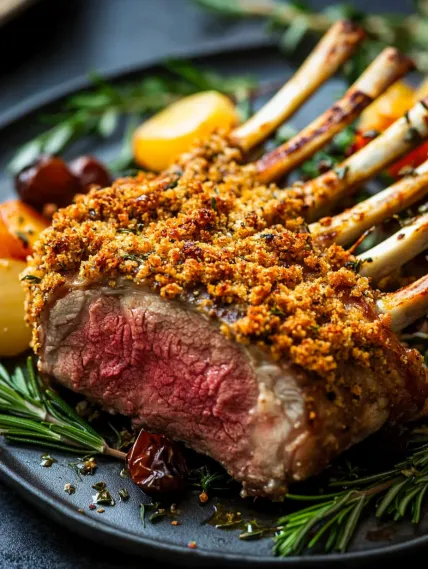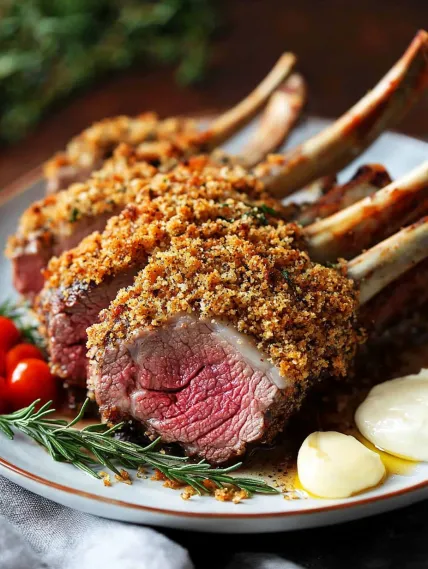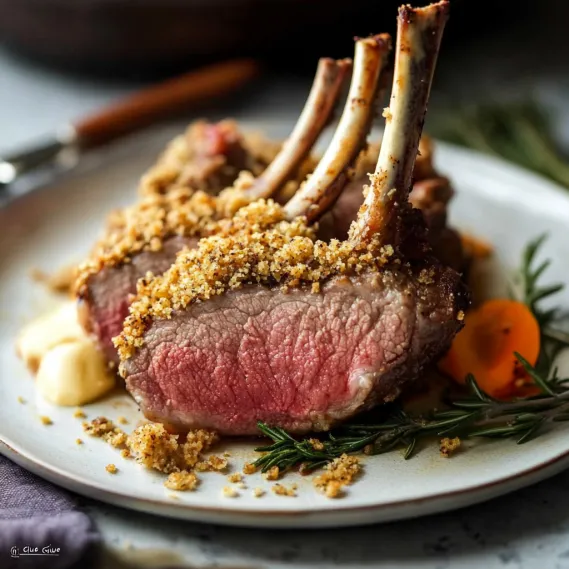 Pin it
Pin it
This rosemary crumbed rack of lamb transforms a premium cut into an unforgettable centerpiece that balances rustic flavor with elegant presentation. The tender, juicy meat is encased in a crisp, golden crust infused with fragrant rosemary and garlic, perfectly complemented by the rich umami notes of parmesan. My special egg trick ensures the coating adheres beautifully throughout roasting, giving you a picture-perfect presentation every time. Whether served simply to showcase the quality of the meat, paired with a luxurious creamy sauce, or presented over vibrant pea puree, this dish delivers restaurant-quality results with surprisingly straightforward preparation.
I first served this at a family gathering where opinions were divided about whether lamb rack needs a sauce. This recipe silenced the debate - the meat was so tender and flavorful that even the sauce enthusiasts agreed it was delicious on its own. That said, the creamy white wine mustard sauce did convert several "no sauce" purists, proving that sometimes more really is more!
Essential Ingredients and Selection Tips
- Rack of Lamb: Look for racks with good marbling and bright red meat. French-trimmed racks are elegant but pricier; racks with the fat cap on are more economical and often juicier.
- Rosemary: Fresh is far superior to dried for this recipe, providing aromatic oils that infuse the crumb coating.
- Dijon Mustard: The tangy depth complements the rich lamb perfectly and helps the crumb adhere. Use smooth rather than grainy for the best coating.
- Breadcrumbs: Panko creates the crispiest crust, but standard breadcrumbs work well too.
- Parmesan: Adds incredible savory depth to the crust. Use freshly grated for the best flavor and texture.
I've discovered through multiple tests that while untrimmed racks with their fat cap intact provide more flavor, removing most of that fat myself and then applying the crumb gives me the best of both worlds - juicy meat with perfect crumb adhesion, at a much more reasonable price point.
Detailed Cooking Instructions
- Step 1: Prepare Your Rack Perfectly
- Season the lamb rack generously with salt and pepper. Heat a large skillet over high heat, add a tablespoon of oil, and sear the rack on all sides until golden brown. This crucial step develops deep flavor through browning reactions and creates the foundation for a spectacular dish.
- Step 2: Create The Flavorful Adhesive
- Mix 2 tablespoons Dijon mustard with 2 teaspoons finely chopped fresh rosemary, 1 minced garlic clove, and 3 teaspoons beaten egg. This unique addition of egg acts as the perfect glue for your crumb coating, preventing the frustrating problem of coating falling off during roasting.
- Step 3: Master The Crumb Application
- Combine 1 cup panko breadcrumbs, 2 tablespoons grated parmesan, 1 tablespoon finely chopped fresh rosemary, and 1 minced garlic clove in a shallow dish. Smear the mustard mixture all over the seared lamb, then press the rack into the crumb mixture, turning and patting to ensure complete coverage.
- Step 4: Roast To Perfect Doneness
- Place the crumbed rack on a baking tray and roast in a preheated 390°F (200°C) oven. For medium-rare (the ideal doneness for lamb), cook until the internal temperature reaches 57°C (135°F), about 20-25 minutes for a Frenched rack or 30-35 minutes for untrimmed. Always use a meat thermometer for precision.
- Step 5: Rest Before Serving
- Allow the lamb to rest for 5-10 minutes before slicing. This crucial step lets juices redistribute throughout the meat, ensuring maximum tenderness and flavor in every bite. Slice between the bones and serve with your choice of accompaniments - either plain to showcase the meat, with creamy white wine mustard sauce, or on a bed of vibrant pea puree.
 Pin it
Pin it
I learned the importance of proper temperature control the hard way. The first time I made this, I relied on timing rather than using a thermometer and ended up with lamb that was slightly overdone. Now I never cook expensive cuts like this without my meat thermometer, ensuring perfect medium-rare results every time.
The Secret To Perfect Wok Technique
High heat is essential for authentic fried rice. My grandmother taught me to heat the wok until smoking before adding oil. Keep ingredients moving constantly to achieve that elusive "wok hei" flavor. Never overcrowd the pan—cook in batches instead. This technique transformed my fried rice into restaurant-quality perfection.
 Pin it
Pin it
Making The Most Of Leftovers
This dish excels at transforming leftovers into something exciting. I've used roast chicken, holiday ham, and even Thanksgiving turkey with great success. Cut meat into uniform pieces that distribute evenly throughout. Leftover grilled steak adds incredible depth with its smoky edges. Even roasted vegetables bring delightful caramelized sweetness.
Balancing Flavors And Textures
Special fried rice succeeds through balanced components. Char siu provides richness, prawns add sweetness, eggs contribute silkiness, while vegetables offer freshness. The sequence matters—aromatics first build flavor, eggs midway remain distinct, vegetables maintain crispness. Adding spring onions last preserves their brightness for that authentic restaurant finish.
Customization For Dietary Needs
This dish adapts easily to dietary restrictions. For vegetarians, I omit meat, double eggs and add extra vegetables. Low-carb diners enjoy my cauliflower rice version that carries flavors beautifully. For gluten-sensitive guests, tamari replaces soy sauce while ensuring chicken powder is certified gluten-free. Everyone enjoys this beloved dish regardless of restrictions.
Three Elegant Serving Options
This versatile dish can be presented in multiple ways, each creating a different dining experience. For purists who appreciate the quality of the meat itself, serve the sliced rack with simple roasted vegetables, allowing the rosemary-infused crust and tender meat to shine. For special occasions, the creamy white wine mustard sauce adds luxurious richness that transforms the dish into something truly celebratory - just spoon it alongside rather than over the lamb so guests can control the amount. My personal favorite presentation is over a vibrant green pea puree, which creates a stunning visual contrast while adding a fresh, sweet complement to the rich lamb. This restaurant-inspired plating never fails to impress dinner guests and makes the meal feel truly special.
Creating A Complete Dinner Party Menu
When serving this as the centerpiece of a dinner party, I pair it with sides that complement without competing. For starters, a light French bistro salad with a simple vinaigrette prepares the palate without filling guests before the main event. For accompanying sides, herb-roasted baby potatoes and simply prepared seasonal vegetables maintain the elegant theme while providing variety. I find that rosemary-infused dishes pair beautifully with the earthiness of mushrooms - a simple sautéed wild mushroom side adds wonderful complexity to the meal. For dessert, something light and fruit-based, like a pear frangipane tart, provides a perfect conclusion that doesn't overwhelm after the rich main course.
Wine Pairing Recommendations
The robust flavors of rosemary and garlic in the crumb coating, combined with the richness of lamb, call for wines with enough structure to stand up to these elements. A medium-bodied Pinot Noir offers the perfect balance - fruity enough to complement the lamb without overwhelming it, with subtle earthy notes that enhance the herb crust. For white wine enthusiasts, a rich Chardonnay with some oak influence can surprisingly hold its own against this dish. When serving with the creamy mustard sauce, consider a Côtes du Rhône or Syrah, as their peppery notes and fuller body stand up beautifully to both the lamb and the sauce. Whatever your selection, serving the wine at the proper temperature (slightly cooled for reds, not too cold for whites) makes all the difference in creating a perfect pairing.
 Pin it
Pin it
This rosemary crumbed rack of lamb has become my signature dish for special occasions and celebrations. What I love most is the perfect balance it strikes between impressive presentation and manageable preparation. The combination of tender, perfectly cooked meat with the crisp, aromatic crust creates a dining experience that feels truly special, whether for a holiday feast or an elevated weekend dinner. Even friends who typically shy away from lamb find themselves converted by this recipe, proving that sometimes the simplest preparations of quality ingredients create the most memorable meals.
Frequently Asked Questions
- → What's the difference between Frenched and untrimmed rack of lamb?
- Frenched racks have the fat and meat trimmed from the bones, creating a cleaner, more elegant presentation typical in restaurants. They're smaller (500-650g for 7-8 bones) and more expensive. Untrimmed racks keep the fat cap and more meat, weighing 750-900g. They're more economical and produce juicier, more flavorful meat as the fat protects and bastes the meat during cooking. Choose based on your preference for presentation versus value and flavor intensity.
- → Why do you add egg to the mustard coating?
- The egg acts as a natural food glue, helping the breadcrumb coating adhere better to the lamb. Without it, the crumb is more likely to fall off during cooking or when serving. While the crumb won't stick like superglue even with egg, it significantly improves the coating's stability. This simple addition makes a noticeable difference in the final presentation and eating experience.
- → How do I know when my rack of lamb is perfectly cooked?
- A meat thermometer is essential for perfectly cooked lamb. For medium-rare (ideal for lamb), remove it from the oven when the internal temperature reaches 57°C/135°F - it will rise to 60°C/145°F while resting. For rare, aim for 47°C/117°F, rising to 52°C/125°F while resting. Cooking times vary significantly based on the size of your rack, so temperature is a much more reliable indicator than time.
- → Is the sauce necessary or can I serve the lamb without it?
- The lamb is absolutely delicious without sauce! The crumb coating provides plenty of flavor and the meat itself is tender and juicy. The Creamy White Wine & Mustard Sauce is completely optional and should be used sparingly if you choose to make it. Another elegant alternative is a vibrant pea puree, which serves as both a side and a sauce while adding beautiful color to the plate.
- → What's the best way to carve rack of lamb with the crumb coating?
- The trickiest part of this dish is carving while keeping the crumb intact. For best results, use a very sharp knife and gently hold the crumb in place with your free hand where you're cutting. If your serving style allows, cut portions with 2-3 bones together (double or triple cutlets) rather than single cutlets, as the crumb stays on better with larger pieces. Let the lamb rest properly before carving to help the crumb set.
- → Can I prepare any components of this dish ahead of time?
- Yes! You can prepare the crumb mixture and the mustard-egg spread up to a day ahead and refrigerate them separately. You can also sear the lamb and apply the coating a few hours before roasting - just keep the prepared rack refrigerated and bring to room temperature 30 minutes before roasting. The white wine sauce can be made 2-3 days ahead and gently reheated. However, for the best crispy crust, the final roasting should be done just before serving.
